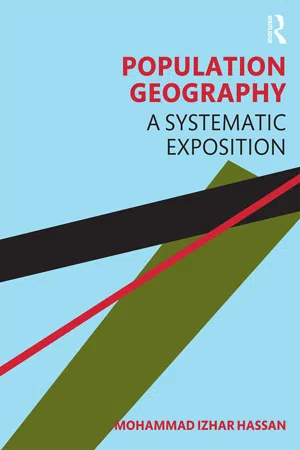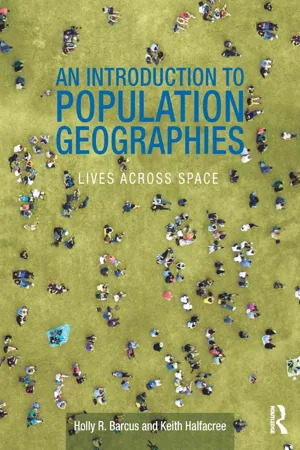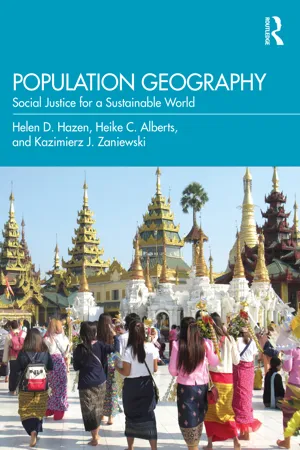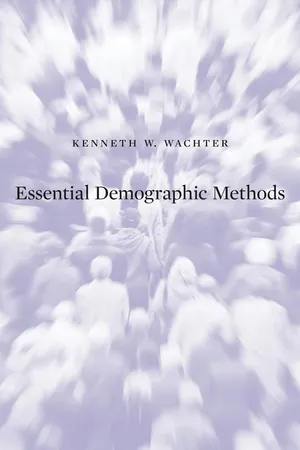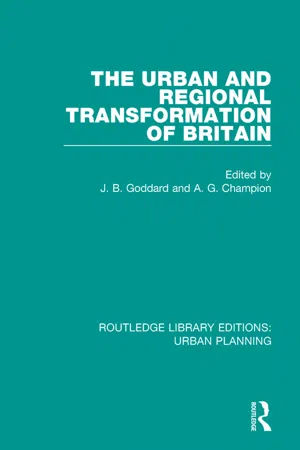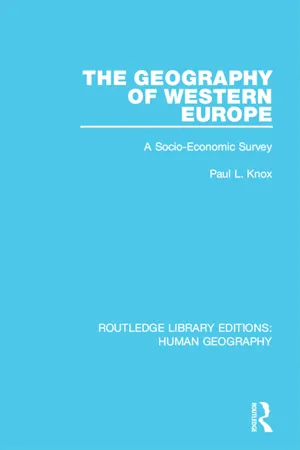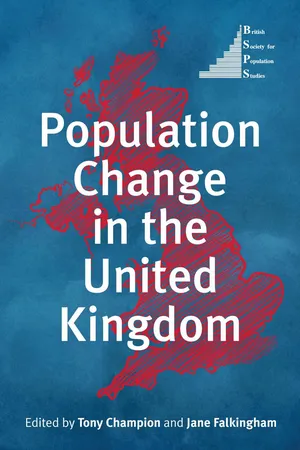Geography
UK Population Distribution
The UK population distribution refers to the spread of people across the country. It is uneven, with the majority of the population concentrated in urban areas, particularly in London and the southeast of England. This pattern is influenced by factors such as employment opportunities, infrastructure, and historical development.
Written by Perlego with AI-assistance
Related key terms
Related key terms
1 of 4
Related key terms
1 of 3
10 Key excerpts on "UK Population Distribution"
- eBook - ePub
Population Geography
A Systematic Exposition
- Mohammad Izhar Hassan(Author)
- 2020(Publication Date)
- Routledge India(Publisher)
3 Population distribution The world is the home of over 7.5 billion people distributed over the globe in a very uneven manner. On the one extreme, vast areas including the hot and the cold deserts, the polar areas, the mountain ranges etc. are either uninhabited or very thinly populated. As against this, the fertile plains with favourable climatic conditions are very densely populated. Less than one-fifth of the land surface accommodates nearly nine-tenths of the world population. Population geographers have traditionally been interested in this uneven spatial expression from region to region and from place to place. The present chapter discusses some of the salient features of population distribution in the world, in general, and in India, in particular. Factors affecting population distribution have also been examined. The terms – distribution and density – are frequently used in any discussion on the distribution of human population. It is, therefore, worthwhile to discuss the exact meaning of the terms and their various measures before we embark upon population distribution. Density and distribution Though density and distribution have precise and distinct connotations, they are sometimes used interchangeably. While distribution refers to the actual pattern of spacing of units of individuals over the earth’s surface, density, on the other hand, is an expression of the ratio between number of people and land surface area. Measures of density Crude density, also known as arithmetic density, is the most commonly used measure of population density. It is expressed as the number of people divided by total surface area. India, for example, has an average density of 382 persons per square kilometre, as per the latest census of 2011. Crude or arithmetic density can be worked out separately for rural and urban areas. Being an average figure, crude density suffers from a serious limitation - eBook - ePub
An Introduction to Population Geographies
Lives Across Space
- Holly R. Barcus, Keith Halfacree(Authors)
- 2017(Publication Date)
- Routledge(Publisher)
These include proximity to resources, historical distribution of lands and land tenure issues, transportation systems, distribution of amenities and individual preferences. They are inextricably entangled with the arenas of life course construction outlined in Section 2.3. In South America, for example, the population is not evenly distributed but clustered along the coastlines and a few interior cities, leaving large areas of low population density. Knowing the extensiveness of the Amazon rainforest and the difficulty of living in the Andes mountains, for example, gives immediate physical geographic clues to these spatial patterns, even if these factors alone are unable to explain the full picture. Figure 3.2 World population distribution 2015. Data Source: Center for International Earth Science Information Network (CIESIN), Columbia University; United Nations Food and Agriculture Programme (FAO); Centro Internacional de Agricultura Tropical (CIAT) 2005; SEDAC. Fortunately, Geographers’ methods to measure population density and distribution have evolved as rapidly as the populations being measured. Censuses (Box 3.2), population registers and surveys that count the number of people who reside in a particular area help production of density measures. Advanced technologies, such as satellite images and aerial photography, can further be employed for population estimation. For example, Rindfuss et al. (2002) utilized Geographic Information Systems and remote sensing to link data about changes in village practices and landscape change in Nang Rong, Thailand. Similarly, Fox (2002) utilized aerial photography and socioeconomic data to assess the multiple dimensions of land change, including the implications of land tenure policies, on land use practices in several villages in northeastern Cambodia - eBook - ePub
Population Geography
Social Justice for a Sustainable World
- Helen D. Hazen, Heike C. Alberts, Kazimierz J. Zaniewski(Authors)
- 2023(Publication Date)
- Routledge(Publisher)
CHAPTER 3 Population distribution and compositionDOI: 10.4324/9781003143253-3After reading this chapter, a student should be able to:- identify major environmental and social factors influencing population distribution and changes to that distribution;
- discuss the significance of major aspects of population structure, including race and ethnicity, sex and gender, and age structure;
- explain why social equity issues frequently arise in connection to population composition.
Population distribution (where people are found across the Earth’s surface) and composition (the characteristics of particular populations) are of great importance to addressing geographic questions of where and why. Issues of population distribution and composition are also of great significance to politicians and administrators entrusted with decision-making tasks, including providing basic services such as healthcare, social support services, and education; determining political representation; and building infrastructure and facilities such as schools, hospitals, and roads. Understanding population distribution and composition can also allow us to identify problems that need to be addressed, such as regional imbalances between population size and resource availability or systematic disadvantages for certain sub-groups of the population.PART I: POPULATION DISTRIBUTION
Population is unevenly distributed at multiple scales. At the global scale, about half of the population is concentrated on just 3 percent of land (excluding Antarctica), and 90 percent of the population occupies 18 percent of land area. The least densely populated regions, comprising half of global land area, support only 0.5 percent of global population. There is more land north of the Equator and we might therefore expect more people there, but the Northern Hemisphere is more than twice as densely populated as the Southern, with 68 persons per square kilometer (176 per square mile), compared with 30 per square kilometer (78 per square mile) in the South. As figure 3.1 - eBook - ePub
Demographics
A Guide to Methods and Data Sources for Media, Business, and Government
- Steven H. Murdock, Chris Kelley, Jeffrey L. Jordan, Beverly Pecotte, Alvin Luedke(Authors)
- 2015(Publication Date)
- Routledge(Publisher)
Chapter 2 Basic Concepts, Definitions, and Geography of Demography As with any area of study, it is essential in demography to understand its basic concepts and the definitions of its key terms and to become familiar with the types of geographic areas for which demographic data are generally available. Knowing the jargon of demography and knowing the types of areas for which data can be obtained are essential first steps in knowing how to effectively use its data. In this chapter, we provide an overview of key concepts and definitions and examine the geographic bases used in demography and its applications. Basic Dimensions and Processes Given the definition of demography as the study of population size, distribution, and composition and of the processes that determine these, a logical place to begin in understanding demographic factors is to understand (1) what is meant by a population; (2) the three key dimensions of population–size, distribution, and composition; and (3) the three basic processes that determine population change–fertility, mortality, and migration. A population refers to the persons living in a specific area at a specific point in time. It refers to the aggregate, the group of people as a whole, in an area. As such, it has characteristics that are unique to an aggregate and are not just the sum of individuals’ traits or characteristics. For example, a population can have a death rate, birth rate, etc., but individuals are either alive or dead, have or have not been born. There is no death or birth “rate” for an individual - eBook - ePub
- Kyle Tredinnick(Author)
- 2024(Publication Date)
- For Dummies(Publisher)
Part 2The Geography of Human Habitation
IN THIS PART …- Preview the indicators geographers use to understand human populations
- Understand population trends and what affects them
- Examine the historical and current forces that influence human migration patterns
- Compare migration types and how they differ around the world
- Define the urban landscape and how geographers study cities and other metropolitan areas
- Compare how urban and rural centers are organized
Passage contains an image Chapter 5
Where Are the People?
IN THIS CHAPTERUnderstanding population trends and patternsHow population and growth are affectedVisualizing demographic informationWith human geography, remember that the people are the primary focus of study — where they are, how they’re distributed, where they’re not and why, and even where they’ve been. In this chapter, I’ll introduce you to how geography studies human populations. Throughout the chapter, we’ll keep a spatial focus. We will delve a bit into where they’ve been over time without going too far into world history.Writing about these topics is a challenge because they cover a lot of ground, and there are many examples I could use. I’ve settled on a few examples to avoid bogging you down in the details, but I encourage you to look for other ways to apply the concepts you’ll learn here.The world’s size and diversity make generalizations difficult because exceptions exist to any sort of rule. Where population geography is concerned, generalizations are especially difficult because migration creates many nuanced regional differences. For example, while China is a unified country, the State itself recognizes 56 minority groups in addition to the Han Chinese ethnic majority. Most countries are similarly diverse, so classifying and mapping out populations is an especially difficult task.Establishing Terms
One thing I must do right away is establish some of the terms that geographers use to talk about different human population groups. Before breaking down the complexity of each term, I will provide a simplistic — not necessarily technical — definition for each. Let’s start by discussing ethnic groups. - eBook - ePub
Britain's Population
Demographic Issues in Contemporary Society
- Steven Jackson(Author)
- 2013(Publication Date)
- Routledge(Publisher)
6MIGRATION AND THE GEOGRAPHY OF POPULATION
The patterns of population change in any given area are determined by the combined effects of prevailing trends in fertility, mortality and migration. As noted, Britain’s population in the 1990s is relatively stable, with little inherent potential for natural growth in the foreseeable future and a probable long-term decline. However, a stable national regime masks the importance of more volatile patterns of change within individual localities. Patterns of fertility and mortality vary from place to place in relation to population structure and local economic performance, but the principal influence on local patterns of change is the movement of population. Some areas of Britain have lost significant numbers over the past twenty years, particularly the inner areas of the major metropolitan centres. Other localities have grown substantially as a result of a sustained influx of migrants. The movement of population not only influences the distribution of total numbers but also impacts on local variations in fertility and mortality. Migration flows tend to be selective in terms of age and social status. The influx to. the expanding centres in the South East tends to be characterized by young, skilled or professional adults with the effect of creating a bulge in the age/sex structure and a rise in underlying trends in fertility. The stream of retirement migrants to the English coastal resorts has the reverse effect, adding to the levels of mortality in the receiving communities.Patterns of population movement occur at different levels and at different scales. In Britain the dominant flows are the general drift of population from the industrial districts of the North and West towards the metropolitan economy in the South and East, and the outflow from the larger towns and metropolitan centres towards suburban and rural districts. This latter stream of movement is commonly referred to as ‘counterurbanization’ and reflects a sustained pattern of population redistribution that has been effective at varying rates throughout the twentieth century. At a more local level there is a constant ebb and flow of movement over short distances as a consequence of residential relocation. In this chapter the complex patterns of population movement, reflecting both dimensions of time and space, will be considered at a number of different scales: international migration, inter-regional movements, intra-regional shifts and local mobility. - eBook - ePub
- Kenneth W. Wachter(Author)
- 2014(Publication Date)
- Harvard University Press(Publisher)
11 Migration and Location11.1 Spatial Demography
People are found in places and move from place to place. All the processes we have been studying occur within space as well as across age and time. In this chapter we turn to methods of spatial demography. We leave behind the fiction of closed populations. In open populations, people enter and exit not just by being born and dying but also by crossing borders or changing categories of legal status. Migration across borders is a major component of population growth in many countries, especially the United States, influencing population composition, politics, economics, and social harmony. Great migrations are part of the drama of history, like the Exodus in the Bible, the trans-Atlantic flows of people to the Americas after 1500, refugees from Hitler, World War II, and other wars and famines, guest-worker entrants to the European Union or to the Gulf states. Movements within countries among regions, among places of different kinds, and especially from rural to urban areas likewise shape history and our own experience. Both movements between nations and movements within nations are treated in Section 11.2. In this era of globalization, however, the “space” that each of us inhabits is virtual as well as physical. We are positioned in networks, in social hierarchies, in structures of identity. Demographers, in partnership with geographers, have developed techniques to study such broader kinds of “locations”. Section 11.3 , by way of example, extends measures for the concentration of residents in cities to measures of concentration of wealth, information, and network connectivity.Today, people can move from place to place by leaps and bounds, by airplane, ship, car, bus, or train. Prehistoric people moved by foot, step by step, here and there. Techniques for understanding haphazard movement, step by step, so-called “random walks”, turn out to have applications throughout migration studies, public health, and forecasting. A few of them are presented in Section 11.4 - eBook - ePub
- John Goddard, Anthony Champion(Authors)
- 2018(Publication Date)
- Routledge(Publisher)
9 Migration within and between labour markets S. R. Kennett Introduction Population redistribution is the most fundamental aspect of change in the urban system. At sub-regional scales, as noted in the previous chapter, migration is the more important and variable determinant of population change. Of the British population in 1971, more than 6 million (or one in eight) were recorded as moving at least once during the previous year. About 17.5 million moved in the five-year period 1966–71, equivalent to more than one-third of the total population or about the size of all the conurbations together. Nevertheless, for various reasons outlined in the first section, the importance of migration has tended to be underestimated. This chapter then outlines some of the features of population movement in the urban system, concentrating on the characteristics of differential migration. This leads to a discussion of the implications of population decentralization for local government fiscal issues, a topic which illustrates the pervasive importance of migration trends. The study of migration in the urban system The migration mechanism itself should be seen as a process rather than a set of independent, unrelated actions. Ideally, it should be viewed through a hierarchically ordered, interacting urban system, instead of a number of discrete towns, cities and rural areas. The temporal dimension is also vital. The influence of previous population distributions and movements should not be overlooked in an analysis of recent trends. The essential characteristics of the present regional population distribution were shaped in the period between the mid-eighteenth century and the First World War. Changes since then have predominantly affected intraregional population patterns - eBook - ePub
The Geography of Western Europe
A Socio-Economic Study
- Paul L Knox(Author)
- 2015(Publication Date)
- Routledge(Publisher)
2 THE DEMOGRAPHIC BACKGROUNDIn Western Europe, as in other regions, the geography of population and the dynamics of population change are closely interrelated with processes of economic development and social change. Patterns of density, fertility, mortality and migration are often a direct reflection of economic, social and political conditions; they are also important determinants of economic change and social well-being at both national and regional levels. Although it is not always easy to unravel cause and effect, it is important to set out at least the major demographic patterns and trends within the region and to identify their linkages with socioeconomic development.Population Distribution and DensityA distinctive characteristic of Western Europe as a whole is the size and relative density of its population. With only 2 per cent of the world’s land surface, Western Europe contains 8.6 per cent of its population at an overall density of nearly 100 persons per km2 . By comparison, the United States contains only 5 per cent of the world’s population at a density of 24 persons per km2 . Within Western Europe the highest national densities (344 per km2 in the Netherlands, 325 per km2 in England and Wales, 322 per km2 in Belgium, and 247 per km2 in West Germany) match those of Asian countries such as Japan (311 per km2 ), the Republic of Korea (382 per km2 ) and Sri Lanka (225 per km2 ). On the other hand, population density in Finland, Norway and Sweden stands at about 15 persons per km2 : the same as in Kansas and Oklahoma.This points to a second distinctive feature of the human geography of Western Europe: the existence of a densely populated core and a sparsely populated periphery. Broadly speaking, this core can be regarded as stretching from the United Kingdom through Belgium, the Netherlands, West Germany and Switzerland to Italy: the six countries with the highest densities and, moreover, with relatively even internal distributions of population at the provincial level (Arnold, Danieli and Zacchia 1981; Biraben and Duhourcau 1973). At the more detailed level of resolution shown by Figure 2.1 it is clear that this core is itself dominated by an intermittent zone of extremely high densities (i.e. more than 250 persons per km2 ). This zone can be traced from its northernmost outlier in the central lowlands of Scotland through the industrial heartlands of the Tyneside, Merseyside, Manchester, West Yorkshire, South Yorkshire and West Midlands conurbations to metropolitan southeastern England and across the Channel to industrialised northeastern France, Belgium and the Randstad Holland conurbation. Southeastwards, it extends into the agricultural-industrial environment of the Börde country between Aachen and Hannover and thence to the heavily industrialised Ruhr conurbation. High densities continue unbroken to the south, following the Rhine as far as Karlsruhe and extending westwards to the Saar coalfield and eastwards to the Neckar basin and Stuttgart. Thereafter, the southward extension of the high-density zone can be traced only intermittently, appearing in the Swiss Mitteland - eBook - ePub
- Tony Champion, Jane Falkingham(Authors)
- 2016(Publication Date)
- Rowman & Littlefield International(Publisher)
Chapter 8 Internal Migration and the Spatial Distribution of Population Tony ChampionThis chapter examines the changing spatial distribution of the UK population and the drivers of this, with a particular focus on internal migration. In doing this, it compares the latest trends with those of the 1970s and 1980s documented by Champion (1989) in Joshi’s book. It is able to identify elements of both continuity and change. Back then, the key themes were seen as the North-South divide, the exodus from the cities and the inner-city problem, all associated to some extent with increasing social polarization. That review had also felt the need to start by justifying the inclusion of a chapter devoted to sub-national patterns as well as bewailing the inadequacy of data on local area populations, especially as it had been written eight years after the most recent Census—a period of great turbulence following the recovery from the 1980–1981 recession and the various shocks instigated by Thatcherism.A quarter of a century on, there is no need to make the case for examining regional and local variations, not least given the devolution trend under New Labour and the subsequent focus on localism and for combined-authority agreements in England. There have also been some substantial improvements in the scope and quality of data relevant to this chapter, especially on migration, traditionally the least well measured of the demographic components. As regards the principal dimensions of spatial redistribution, the North-South divide is still a source of national concern, but the drivers of this have changed, as shown in the next section. Secondly, although there is still net migration out of cities, there has been a major urban recovery since the 1980s, with city-centre population growth tending to upstage inner-city issues. In the third section, the chapter probes a newly recognized development concerning the declining frequency with which most types of people are moving home, which is becoming more apparent now that four decades of data are available.
Index pages curate the most relevant extracts from our library of academic textbooks. They’ve been created using an in-house natural language model (NLM), each adding context and meaning to key research topics.
Explore more topic indexes
Explore more topic indexes
1 of 6
Explore more topic indexes
1 of 4
